MXA RETRO TEST: WE RIDE KEVIN WINDHAM’S 2011 GEICO HONDA CRF450
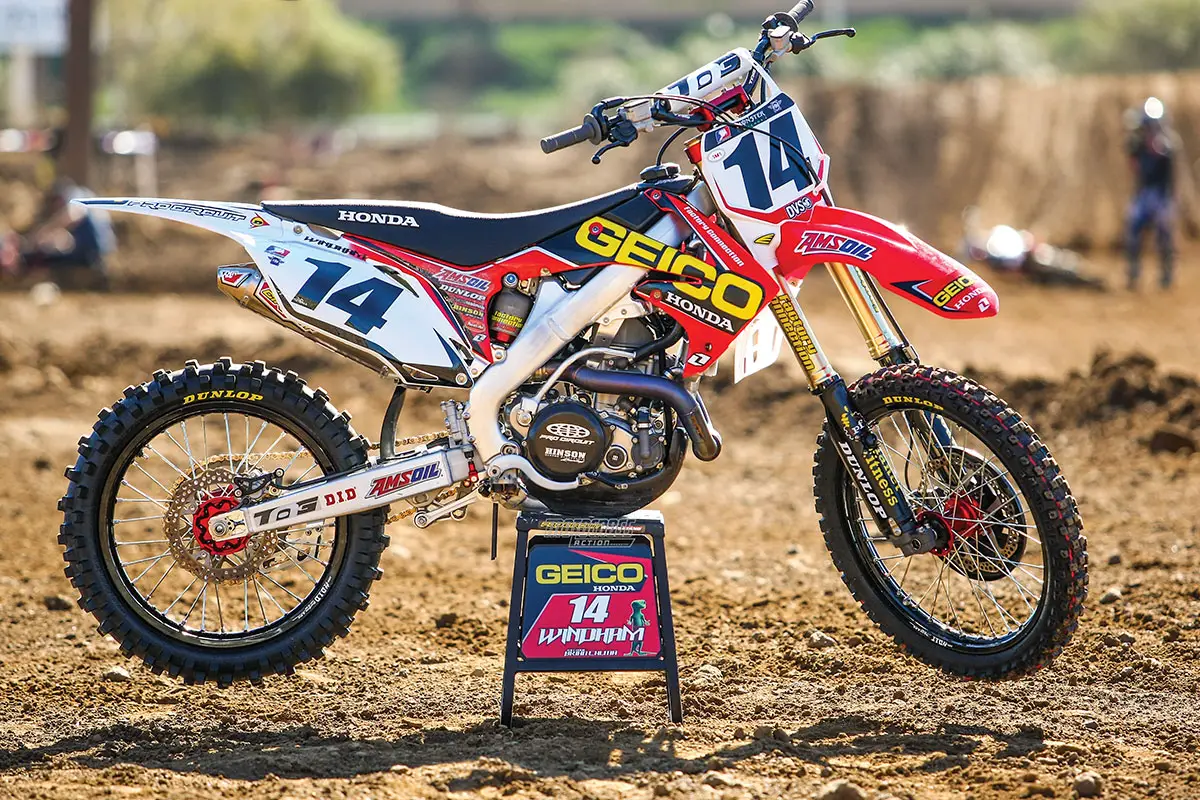
We get misty-eyed sometimes thinking about past bikes we loved, as well as ones that should remain forgotten. We take you on a trip down memory lane with bike tests that got filed away and disregarded in the MXA archives. We reminisce on a piece of moto history that has been resurrected. Here is our test of Kevin Windham’s 2011 Geico Honda CRF450.
Is it so strange to believe that a wily veteran entering the twilight of his illustrious career has received the most fanfare among the droves of Supercross fans in 2011? Or that the soft-spoken man/child with a friendly southern drawl still challenges riders nearly half his age? In stadiums fit for gladiatorial warfare, Kevin Windham is the people’s champ—a rider from the people, so to speak.
Kevin Windham has earned a legion of steadfast fans because he is a perennial contender. More important, he’s a good guy. Championship opportunities have come within grasp for “K-Dub” but always eluded him. While two dynamos—by the names of Jeremy McGrath and Ricky Carmichael—kept Kevin from hoisting the Championship trophy, they have both retired while Windham still remains.
Does Kevin race for money? Certainly not, because he has a healthy spread of land and a gorgeous home in Mississippi. Does he race for fame? No, he’s already about as famous as a motocross racer can become. Does he race for love? Yes, resoundingly so. Is racing his life? Yes, at 33 years old, Kevin has raced at the upper levels of the sport for half of his life. Money, fame, love and life, those are the shoes that Kevin Windham walks in.
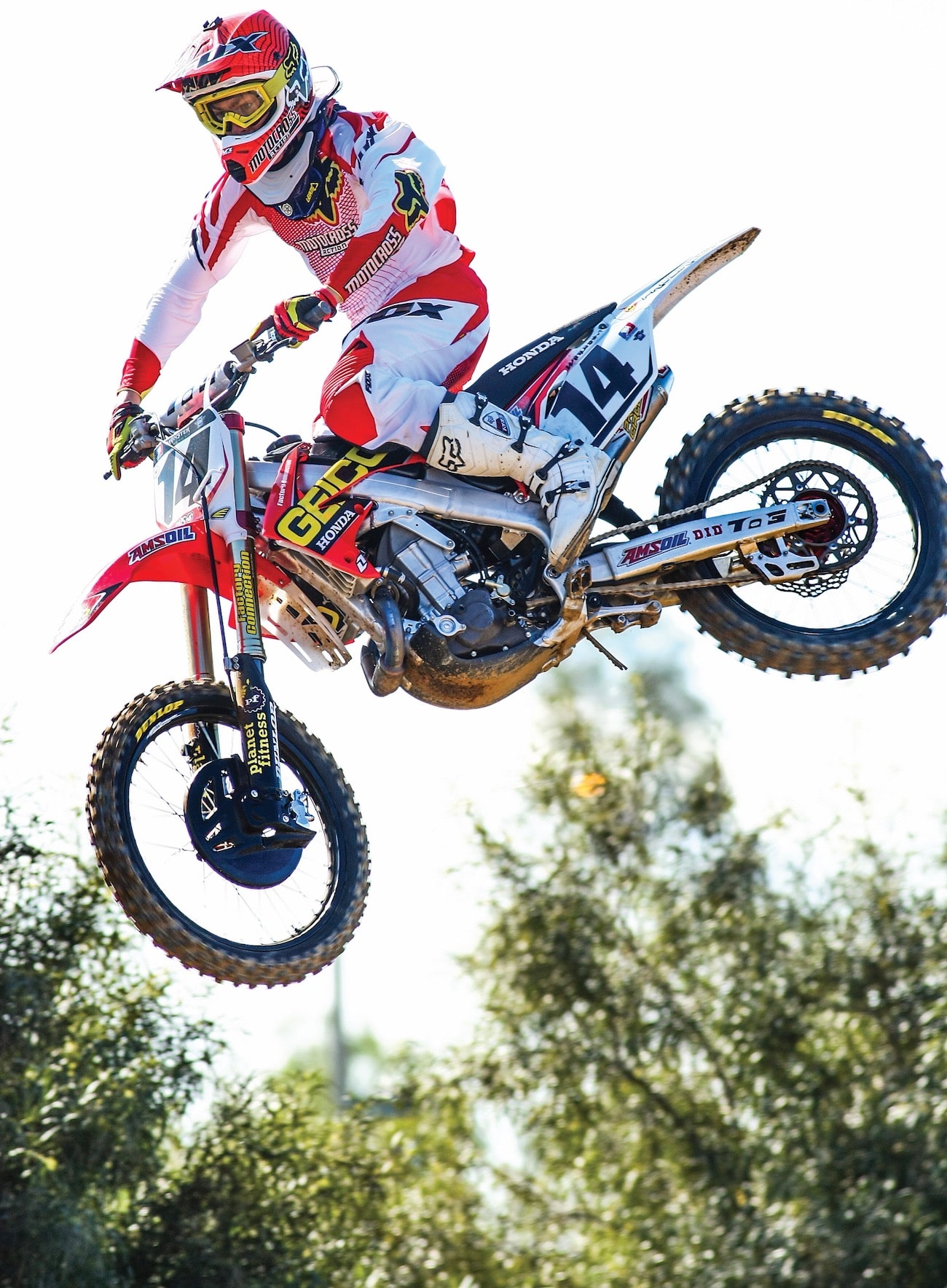
The MXA wrecking crew has followed Windham since the very first day that he turned Pro. In his 18 years on the circuit, Kevin has won races, lost championships by the skin of his teeth, suffered debilitating injuries, nearly quit the sport altogether and made some of the sport’s greatest comebacks.
Every step of the way MXA has documented his ups and downs. As a result, Windham has loved MXA, hated MXA and (as far as we know) is on our side once again. It’s not our business to hate any professional rider, only to tell the truth, which is often misconstrued as hate.
We like testing Windham’s race bikes just as much as we like him. Why? Not only does Kevin have a real world racing setup that doesn’t take a Greek god to ride, but every year since 1995 he has been on factory equipment. His bikes are trick. And, while Kevin’s career has aged like a fine wine, his bike setup has only improved with each passing year. The MXA wrecking crew has tested every conceivable type of motocross bike—from ragtag jalopies to pristine iron—we’ve seen it all. Kevin Windham’s Geico/Honda CRF450 might be defined by its rare and unobtainable works parts, but we see his steed in a different light than most. Kevin’s bike is the byproduct of hard work and dedication; a result of a real-world racer coming to terms with a machine that, for all its peccadilloes, can be the ultimate Supercross weapon.
The Geico/Honda team is a very cool team. We enjoy chewing the fat with team manager Mike LaRocco and Geico/Honda’s technical director, Kristian Kibby. Which is why, when asked to give us Kevin Windham’s race bike, they readily acquiesced to our request.
 Windham’s works transmission was changed to closer ratios between gears. Kevin ran three more teeth on the rear sprocket.
Windham’s works transmission was changed to closer ratios between gears. Kevin ran three more teeth on the rear sprocket.
SHOP TALK: BREAKING IT DOWN
The MXA wrecking crew isn’t shy in expressing our disappointment in the 2011 Honda CRF450. In stock trim the bike is unbalanced, the forks are soft, the handling is weird and the power is decidedly mellow. For all our whining, the CRF450 does have a bright spot. With enough patience and money, the 2011 Honda CRF450 can be transformed into a serious racing machine.
The Geico/Honda team has the experience, time and money to boost the CRF450’s performance enough to meet Windham’s expectations. The team focused on the key problem areas. Many of these changes were mandatory, as Supercross is extremely demanding on equipment.
Transmission: The Honda factory supplies a works transmission for Windham. How does a works transmission vary from a stock tranny? For starters, the gear ratios are different. The gears are tightened up between ratios to avoid any unwanted gaps. The gears are polished for more accurate shifting, and the transmission is made of a higher grade of metal for greater durability. Kristian Kibby stated that the works transmission probably wouldn’t be necessary if the bike didn’t have to endure constant heavy loads while pounding through Supercross whoops. As for the drive train, K-Dub usually runs a 13/51 combination (stock is a 48-tooth rear sprocket).

Engine: Every aspect of Windham’s Geico/Honda CRF450 engine is massaged in order to punch up the powerband. The Geico team relies heavily on Pro Circuit for their power equation. Need proof? Pro Circuit supplies the cylinder head, camshaft, valves, valve springs, valve seats, retainers, high-compression piston, radiator hoses and exhaust system. It’s only natural that a Pro Circuit Ti-4R titanium exhaust is paired with the engine (the muffler has been shortened for improved bottom-end power).
Athena supplies the gaskets, while Renegade Racing SX4+ high-grade AMA-legal racing fuel powers Windham’s bike. A Hinson clutch basket, inner hub, pressure plate and clutch springs are used (oh, yeah, Kevin runs a six-spring clutch instead of the stock four-spring model to prevent slipping). Honda provides Kevin with an unobtainium hydraulic clutch system. And, while the Geico/Honda team is sponsored by Moto Tassinari, at the time of this test Windham’s bike didn’t have the tunable Air4orce intake system. The team expects to use this system once more testing has been done.
The ECU mapping has been tweaked to pump up the performance of the revitalized engine. Windham relies on a Vortex X10 programmable ECU that is personally mapped by Kristian Kibby. Surprisingly, Windham’s bike does not have different maps for each gear. Although the team did test the concept of using different mapping settings for each specific gear, they don’t feel that it was necessary. It should be noted that even though Kevin’s CRF450 has a five-speed gearbox, Windham typically uses only two gears in Supercross.
 The pucker power came from a works caliper mated to a Moto Stuff 270mm front rotor.
The pucker power came from a works caliper mated to a Moto Stuff 270mm front rotor.
As for the EFI throttle body, it has been modified by Injectioneering for radically improved throttle response. Windham prefers the older model 50mm throttle body over the 2011’s 43mm Keihin venturi. Why? The smaller throttle body was designed to improve bottom end power, but Windham doesn’t use low revs very often during a race. As Kibby stated, “It’s an overall package thing. You might have a bottom end pipe and a throttle body that helps the top end. This overall package is happiest with a 50mm throttle body.”
Forks: For two years now Kevin has opted to run production 48mm Showa forks from a CRF250 over Honda’s works units. Most riders would spring for the high-status, 50mm works forks, but they would do it for the wrong reasons. While Showa works forks are expensive, high-tech, and built to sustain high impacts, they aren’t practical for 99.9 percent of riders (and Kevin Windham includes himself in the majority). K-Dub prefers the flex characteristics of the stock CRF250 Showa forks, because they are more forgiving. It should be noted that the 2011 Honda CRF450 comes stock with Kayaba forks.
Factory Connection works their magic on the suspension internals (obviously the valving is on the stiff side for the sake of Supercross rhythm sections and whoops). External coatings, such as titanium nitrate, have been used on the fork tubes and other key areas to prevent stiction. It should be mentioned that Windham prefers the standard offset triple clamps with the standard races—and that Factory Connection re-valved the steering damper.
Shock: Windham’s riding style is as smooth as silk, but that doesn’t mean that he’s not hard on his shock. Last year, while testing Trey Canard’s Geico/Honda CRF250, the MXA wrecking crew learned that Kevin had bent several shock shafts during preseason testing, so we weren’t surprised to discover that Windham relies on a works Showa shock with a super-sized shock shaft. Nothing short of an elephant seat bouncing a triple would make this shock shaft bend. A titanium shock spring is used to save weight. The shock’s internals have been re-valved by Factory Connection, and a secondary shock reservoir has been used for added nitrogen volume. The extra reservoir is routed inside the airbox for safe stowing. Unlike the works Showa shock, the Factory Connection secondary shock reservoir is available to the public.
Miscellaneous: Since Kevin is a tall guy, he runs the standard-height subframe. And while the complete linkage is stock (including the pull-rods), Kevin’s footpegs have been moved 5mm up and 5mm back on the frame. Kevin prefers this placement because it puts more weight on the rear wheel. For the Geico/Honda team, the best fix is to move Kevin back on the bike, since it’s an easier task than moving the engine back in the frame.
Hubs: Although Windham’s CRF450 hubs look like exotic works hubs, they are actually TCR Racing hubs. Geico runs D.I.D. Dirt Star LT-X rims. Most teams use the stronger model Dirt Star rims (without the LT-X nomenclature), but the Geico/Honda team feels that they can get away with using lighter rims to lessen unsprung weight.
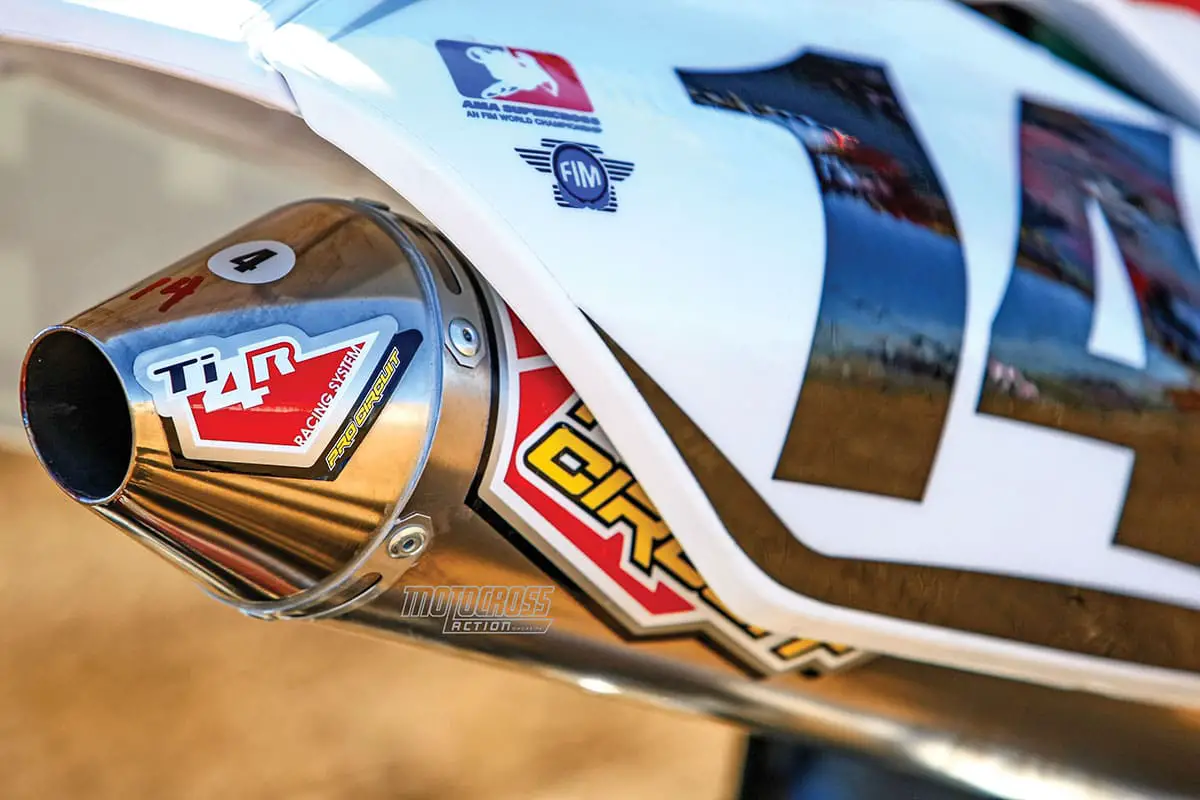 Back in 2011 Pro Circuit’s titanium pipe designation was Ti-4R. Today it is Ti-6R.
Back in 2011 Pro Circuit’s titanium pipe designation was Ti-4R. Today it is Ti-6R.
Brakes: It’s important that a Supercross bike be capable of stopping quickly, which is why Windham uses a gigantic works front brake caliper with a 270mm rotor from CRF Stuff (the rear rotor is a 240). Geico uses stock Honda front and rear brake pads. A System Tech Racing (STR) rear brake clevis, made from billet aluminum (with a titanium pin), is also found on K-Dub’s machine. Kevin relies on ARC folding levers, and his rear brake pedal has a brake snake that the team made to prevent the brake from bending or breaking off completely from a crash or rock jamming between the clutch cover and pedal.
Tidbits: Other performance modifications include reinforced radiators for minor impacts. Kristian Kibby said, “We reinforce them just enough to make sure that the radiators can finish a race.” And although Kevin doesn’t use knee braces, which often tear up the side panels and frame, he squeezes so hard against the subframe that it causes the side panels to bow in. These areas have been reinforced to prevent the side panels from bending. In the unobtainable department is a works Honda shifter with a rubber tip, which is made of forged steel (instead of forged aluminum). This material difference allows the shifter to bend instead of snapping.
Weight: Windham’s bike isn’t significantly lighter than a stock CRF450, due to the fact that several parts on the bike are heavier than stock in order to handle the demands of Supercross. Geico/Honda does use Mettec titanium fasteners throughout the bike, including the swingarm pivot and engine mounts. K-Dub’s machine also contains aluminum fasteners, which are made by a team-commissioned machinist. This machinist also makes Windham’s holeshot device.
In an effort to protect Windham’s bike, there’s a one-piece LightSpeed carbon fiber skid plate that wraps around the underside of the engine. Also, a longer chain guide was designed by Factory Honda and built by Geico/Honda.
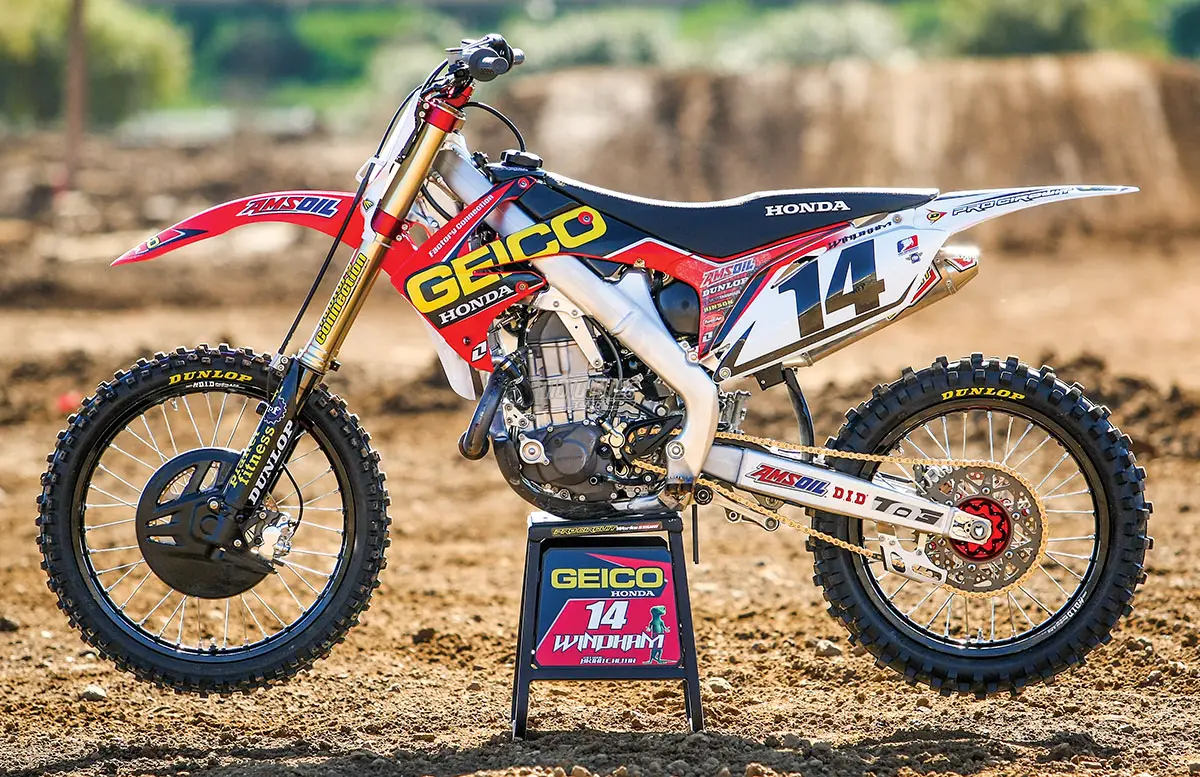 Kevin preferred the flexy feel of the stock 48mm Showas forks over the 50mm works units.
Kevin preferred the flexy feel of the stock 48mm Showas forks over the 50mm works units.
Kristian Kibby wanted to make it known that the team tries to make a lot of things themselves. Kibby says that even though the process is expensive, it is in the team’s best interest. “There are a lot of things on the market that I don’t think are designed properly. A lot of people make things that look cool or might be beneficial in one or two areas, but many of these designs are lacking in other areas. When we plan on replacing a stock component, we ask ourselves what we’re trying to achieve, and, if by doing so, whether it will present other problems. The companies that you see on Kevin’s bike went through rigorous testing, and we loved every aspect of their parts.”
The aftermarket companies that provide products for Windham’s bike are short but sweet. These parts include Cycra plastic (with Powerflow air intake shrouds); One Industries graphics; D.I.D. chain and the aforementioned Dirt Star LT-X rims; Tag sprockets, grips and handlebars; LightSpeed skid plate and oversized titanium footpegs; suspension and engine coatings by Carbon Raptor; Hinson clutch, as well as engine plugs; and, as is common with most top-tier race teams, a Twin Air air filter.
While we circled Windham’s CRF450 like vultures, Kibby removed the seat to reveal the Twin Air filter and proudly display a titanium air filter bolt. When asked why a titanium air filter bolt was necessary, he smiled and replied, “Because it feels good on your fingers when you’re tightening it, and you can feel superior to other people.” After laughing for a minute, he continued, “The riders get pumped on their bike when there’s unobtainable stuff on one, but if it ends up being that way, then that’s an advantage. We don’t have a run-of-the-mill bike.” No, Kevin Windham certainly does not.
 The triple clamps are trick, but Kevin prefers to run the stock offset and revalved HPSD steering damper.
The triple clamps are trick, but Kevin prefers to run the stock offset and revalved HPSD steering damper.
TEST RIDE: DROPPING THE HAMMER
Having known the backstory on Kevin Windham’s Geico/Honda CRF450, we were excited to throw a leg over his bike. We knew that Kevin’s settings were geared towards a real-world racer. The MXA wrecking crew has had its best moments testing the bikes of the stars, but we have also gone home from a test session with loose fillings from the bone-jarring suspension.
In stock form the Honda CRF450 is as balanced as Charlie Sheen after a 36-hour bender at his Hollywood mansion. Not so with Kevin Windham’s CRF450. Obviously, the valving was significantly stiffer to prevent the suspension from bottoming out. In small to moderate G-out sections, such as straightaways and shallow ruts, the forks and shock worked in unison to keep the works Dunlop tires planted.
It was this trait that steered test riders into thinking that Windham preferred soft suspension. They were only half right. In the first part of the stroke Kevin’s suspension was rather plush, considering how many Supercross riders opt for all-stiff all-the-time settings. But, when compressed past the mid-stroke, Windham’s forks became extremely stiff. To MXA’s way of thinking, Windham’s progressive suspension settings seem to be more logical and effective than the extremely stiff settings that James Stewart or Chad Reed would run.
Kristian Kibby provided a useful bit of information after our initial series of laps on Windham’s CRF450. “The suspension is rather plush compared to his competitors. He’s able to conquer the whoops without putting as heavy a focus on that section, so he doesn’t need super-stiff suspension. Instead, we have focused on Kevin being able to navigate turns and have good grip through corners.”
As for engine performance, we expected a low-to-midrange powerband that belched hot fire when the throttle was snapped open. This wasn’t the case. We should have figured out as much because Windham is a cerebral rider. He doesn’t need the most horsepower at his fingertips, but instead a usable powerband that will excel in any situation. His engine was strong off the bottom but not explosive. It climbed rapidly through the midrange and didn’t give up the ghost until well into the top end. It was most potent slightly below the middle and well into the top end (an area that covers the rhythm sections, triples and whoops).
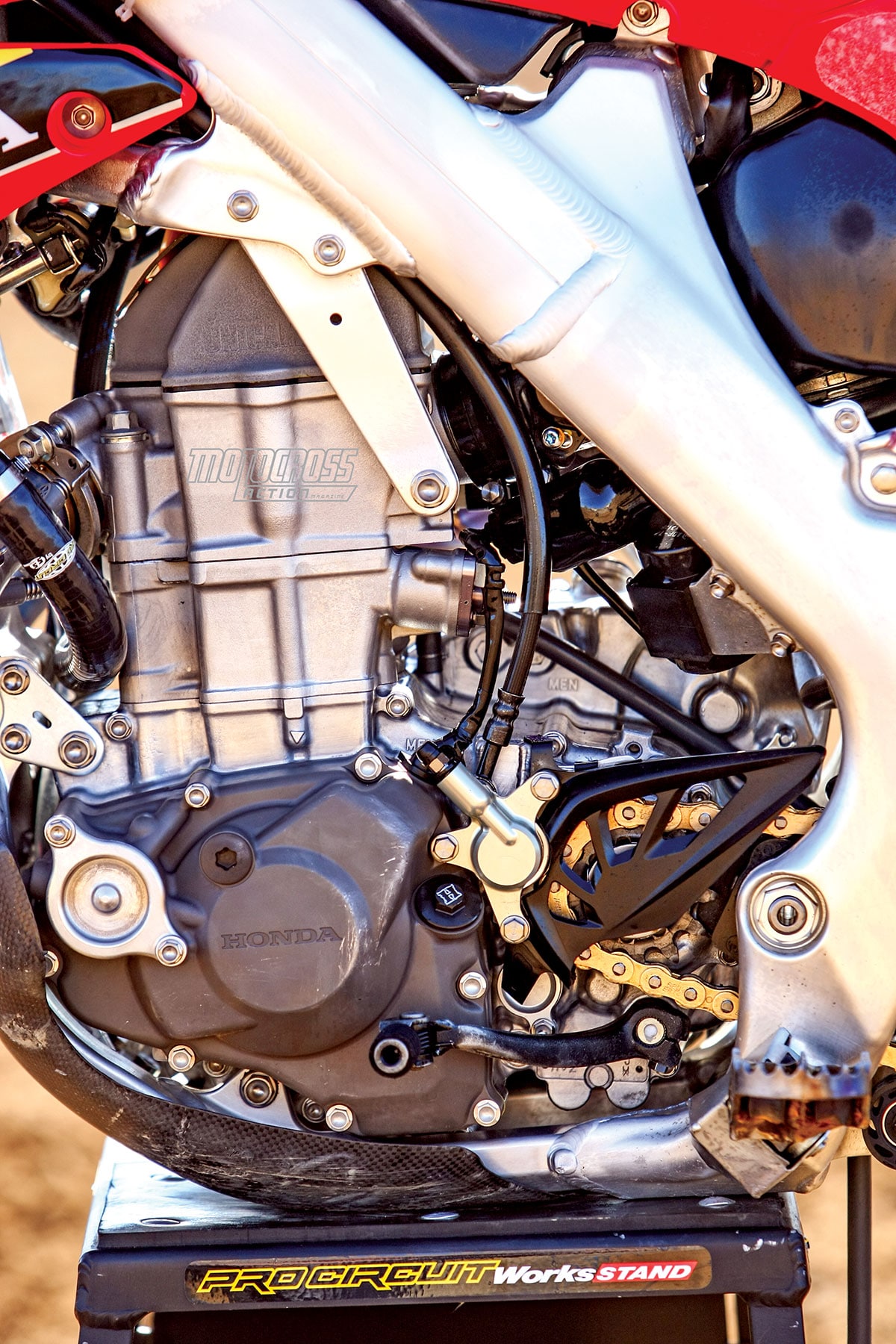
We didn’t realize how big Kevin Windham’s hands were until we pulled in his levers. The front brake lever was set further out than the clutch lever. MXA test riders raved about the feel of the ARC levers (when we were able to reach them). Not surprisingly the front brake was very sensitive, but also progressive. After all, how do you think that Windham is able to pull those extraordinarily long stoppies during the Supercross opening ceremonies? We especially loved the feel of Honda’s works hydraulic clutch. Throughout our test, the clutch worked well and didn’t show any signs of slipping or fading.
Windham’s CRF450 felt light and flickable in the air and reasonably planted in corners. Factory Connection re-valved the steering damper, but most test riders barely noticed any drag from the damper. The front end tracked straight and was very stable for a Supercross bike (not to mention a CRF450). The placement of Kevin’s seat hump was somewhat uncomfortable for taller test riders. Imagine being goosed every time that you sit down. Needless to say, we were constantly reminded to move forward in the cockpit.
All in all, Kevin’s bike was an everyman machine. It didn’t breathe fire, wasn’t stiff as a board, didn’t have the handlebars aimed at weird angles and didn’t require the reflexes of an acrobat to hang on to. It was just like Kevin himself—a well-centered machine that knew what the job was before it took it on.
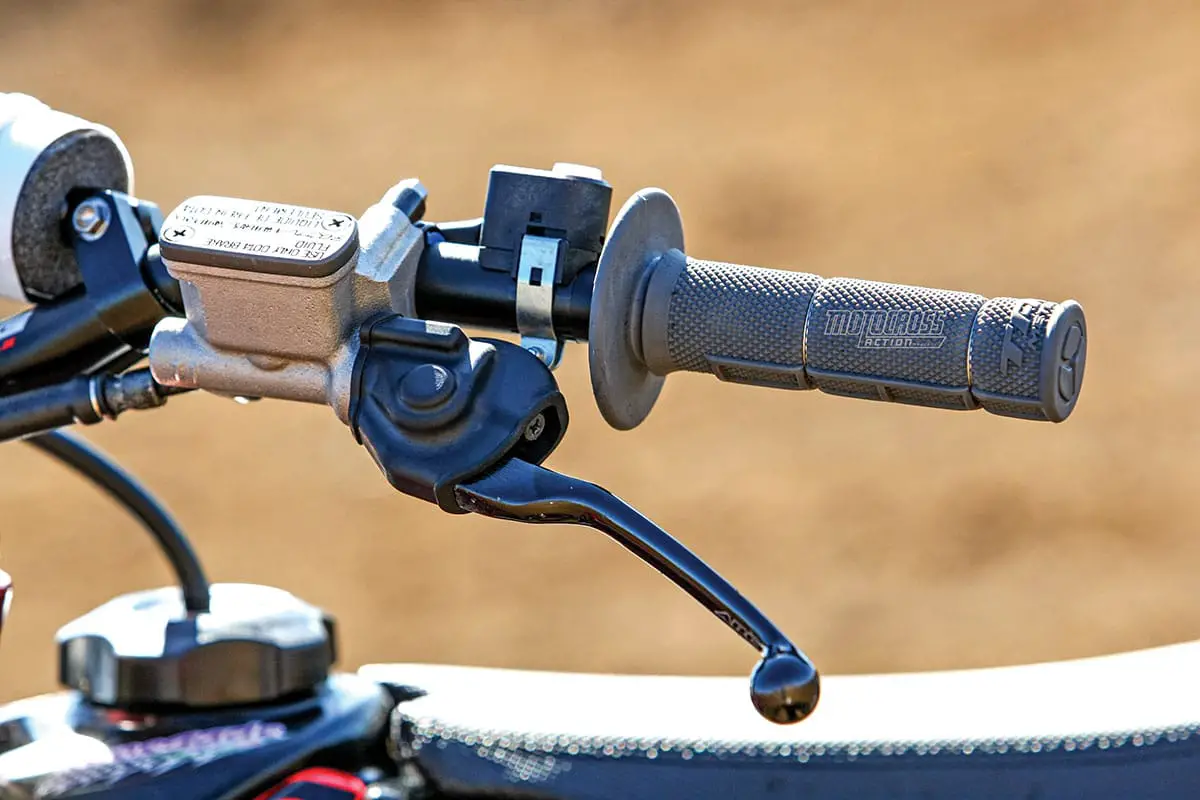 Kevin’s Geico Honda ran a works hydraulic clutch back in 2011.
Kevin’s Geico Honda ran a works hydraulic clutch back in 2011.
WHAT DO WE REALLY THINK?
The MXA wrecking crew is full of Kevin Windham fans. The day that Kevin decides to call it quits will be a sad moment for the motocross industry. It may be true that K-Dub hasn’t accumulated the most titles, but great riders aren’t measured in trophies on the mantle as much as the love to the fans. More than many men before him or those who will come after him, Windham understands that his actions can have a lasting impact. His life has been positive because everything he has been through in his life has made him into a real man. He doesn’t have the haughty star persona of some of his compatriots, because he has been up, down and all around.
Long after the sun sets on Kevin Windham’s career, the MXA wrecking crew will be proud to say that we witnessed his rise to stardom from day one, loved the time we spent with him and, as a bonus, got to test his race bikes along the way.






Comments are closed.